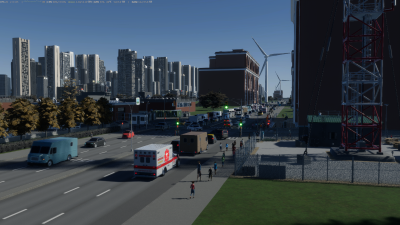交通
阅读
2025-06-08更新
最新编辑:xl123071
阅读:
更新日期:2025-06-08
最新编辑:xl123071
城市:天际线2 会单独追踪每辆车辆通过城市道路系统的行驶路径。这些车辆包括服务车辆、市民的私人交通工具、公共交通和货运车辆。管理道路的交通流量至关重要,因为道路堵塞会导致服务车辆无法及时到达某些区域,这可能导致严重后果,例如火灾或市民死亡与生病,并增加噪音污染。
游戏中的车辆会根据运行成本选择合适的路线。该成本是通过多种因素计算得出的,包括城市的道路网络、旅行时间、出行费用、算法的偏好等等,我们将在下文中更详细地介绍这些内容。此外,车辆还会根据沿途发生的事件调整他们的路线。例如,他们可能会变换车道以避开交通事故或停在路上的服务车辆,或是为正在执行紧急任务的车辆让出通道。
路径选择
路径查找计算的核心包含四个方面:时间、舒适度、成本和偏好行为。
时间 是成年市民的首要考量因素。尽管其他因素会影响路径查找,但时间通常最为重要——所有代理倾向于选择最快到达目的地的路线。仅从旅行时间来看,小型道路可能较短,但其通行速度低于长途高速的通行速度,因此在大多数情况下,成年人的寻路算法会选择整体更快的高速公路。
舒适度 是老年市民的首要考量因素,包含规划尽可能平滑的路线(例如减少交叉路口的无谓转弯),以及寻找合适的停车位或公共交通站点下车。舒适度会直接计入路径查找成本,每种选项都会增加总体成本。
成本 是青少年市民的首要考量因素,通过燃油消耗和潜在停车费等形式影响路径选择。市民会权衡出行和停车成本,并与其他出行选项及步行进行比较,以找到快速、舒适且经济的方案。对于配送车辆而言,运输资源的距离越远,成本越高,因此本地销售资源和商品对企业的成本效益更高,因为配送成本低于将货物运送到外部枢纽的费用。
偏好行为 指寻路算法在交通中做出“危险”决策的倾向(例如U型转弯)。普通市民和配送车辆较少在交通中冒险以降低路径查找成本,而紧急车辆的行为更为宽松,以便在紧急情况下灵活穿行道路网络并做出必要的危险路径决策(例如为缩短路径非法掉头)。如果条件允许,其他车辆会通过在多车道道路上变换车道为应急车辆主动让行。
服务车辆的调度基于最低总体路径查找成本,新决策生成时会综合考虑所有可用车辆当前及近期的位置(即:完成当前任务后车辆会抵达何处)。例如,道路维护服务车辆接到修复某路段的指令时,系统会检查所有可用车辆的当前位置及其当前任务的目标地点。一辆当前更近的车辆可能不会被选中执行新任务,因为另一辆即将完成当前任务后会很快抵达附近位置。
资源运输受路线长度影响显著——距离越长成本越高,因此企业会尽量将货物运送到最近的地点以提高自身利润率。将资源和商品运出城市成本极高,可能大幅降低企业的盈利能力。
交通事故
城市:天际线2 引入了车辆失控撞向道路或建筑物的交通事故机制。事故发生的概率按道路段计算,受道路状况、照明条件、天气和灾害等因素影响。通过道路维护服务和设置路灯保持道路良好状态,是降低道路事故概率的有效方式。
当事故发生时,路段上的车辆会失控并向随机方向偏移。碰撞物理机制允许其撞击路径上的任何障碍物,若与其他车辆发生碰撞还可能引发连锁反应。
事故现场需要由警察和道路维护部门分别进行封锁和清理。受影响的车道将被交通阻断,若所有车道均被阻断则整条道路将瘫痪。若事故严重到造成重伤,急救车辆也会被调派至现场。若事故清理导致长时间交通拥堵,寻路算法可能会重新计算路径并做出转弯,寻找绕开堵塞车道的替代路线。
城际交通
城市:天际线2 中交通也会跨过城市流动,从一个外部连接到另一个外部连接。此类交通通常不会直接影响城市经济,但随着城市扩张和高速公路融入城市道路网络,这些交通流会成为整体交通的一部分。若玩家在两个外部连接之间建造了更短的路线,当该路线在寻路算法中具有更低的成本时,城市间的交通将切换至新路线。
交通监测
道路拥堵或车流密集的情况可通过肉眼观察车辆通行状态判断。长队列会非常明显。观察交叉口或路口的交通流动(或缺乏流动)可为交通问题的成因及解决方案提供线索。
游戏还提供了交通信息视图。点击后会在道路上叠加由绿色到红色的渐变色,颜色深浅反映交通流畅度。通过地图图例选择 "交通流量" 可启用第二视图。点击道路名称可获取该道路的详细信息。
参考资料



 沪公网安备 31011002002714 号
沪公网安备 31011002002714 号